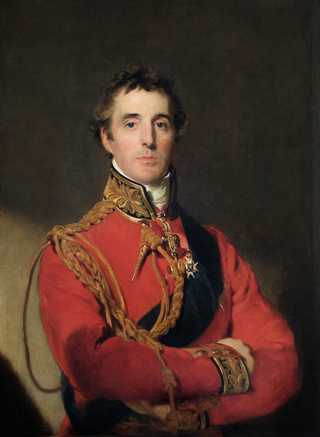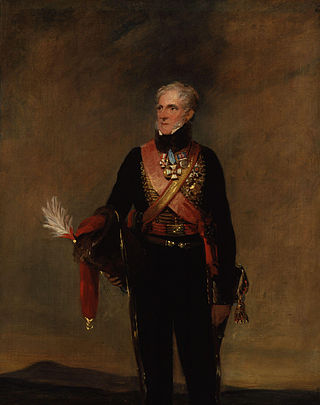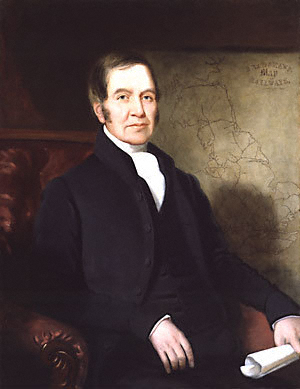Related Research Articles

Field Marshal Arthur Wellesley, 1st Duke of Wellington, was an Anglo-Irish statesman, soldier, and Tory politician who was one of the leading military and political figures of 19th-century Britain, serving twice as prime minister of the United Kingdom. He is among the commanders who won and ended the Napoleonic Wars when the Seventh Coalition defeated Napoleon at the Battle of Waterloo in 1815.

Henry William Paget, 1st Marquess of Anglesey, styled Lord Paget between 1784 and 1812 and known as the Earl of Uxbridge between 1812 and 1815, was a British Army officer and politician. After serving as a member of parliament for Carnarvon and then for Milborne Port, he took part in the Flanders Campaign and then commanded the cavalry for Sir John Moore's army in Spain during the Peninsular War; his cavalry showed distinct superiority over their French counterparts at the Battle of Sahagún and at the Battle of Benavente, where he defeated the elite chasseurs of the French Imperial Guard. During the Hundred Days he led the charge of the heavy cavalry against Comte d'Erlon's column at the Battle of Waterloo. At the end of the battle, he lost part of one leg to a cannonball. In later life he served twice as Master-General of the Ordnance and twice as Lord Lieutenant of Ireland.

The Most Ancient and Most Noble Order of the Thistle is an order of chivalry associated with Scotland. The current version of the order was founded in 1687 by King James VII of Scotland, who asserted that he was reviving an earlier order. The order consists of the sovereign and sixteen knights and ladies, as well as certain "extra" knights. The sovereign alone grants membership of the order; they are not advised by the government, as occurs with most other orders.

The Order of St John, short for Most Venerable Order of the Hospital of Saint John of Jerusalem and also known as St John International, is a British royal order of chivalry constituted in 1888 by royal charter from Queen Victoria and dedicated to St John the Baptist.

A top hat is a tall, flat-crowned hat traditionally associated with formal wear in Western dress codes, meaning white tie, morning dress, or frock coat. Traditionally made of black silk or sometimes grey, the top hat emerged in Western fashion by the end of the 18th century. Although it declined by the time of the counterculture of the 1960s, it remains a formal fashion accessory. A collapsible variant of a top hat, developed in the 19th century, is known as an opera hat.

Events from the year 1797 in Canada.

An Ideal Husband is a four-act play by Oscar Wilde that revolves around blackmail and political corruption, and touches on the themes of public and private honour. It was first produced at the Haymarket Theatre, London in 1895 and ran for 124 performances. It has been revived in many theatre productions and adapted for the cinema, radio and television.

George Gillespie was a Scottish theologian.
Ebenezer Jones wrote a good deal of poetry of very unequal merit, but at his best shows a true poetic vein. He was befriended by Browning and Rossetti.

George Bradshaw was an English cartographer, printer and publisher. He developed Bradshaw's Guide, a widely sold series of combined railway guides and timetables.

Alaric Alexander Watts was a British poet and journalist, born in London. His life was dedicated to newspaper creation and editing, and he was seen as a conservative writer. It led him to bankruptcy, when a pension was awarded to him by a friend, Lord Aberdeen.

Jack the Ripper was an unidentified serial killer active in and around the impoverished Whitechapel district of London, England, in 1888. In both criminal case files and the contemporaneous journalistic accounts, the killer was also called the Whitechapel Murderer and Leather Apron.
Events from the year 1849 in the United Kingdom.

Lord Uxbridge's leg was shattered, probably by a piece of case shot, at the Battle of Waterloo and removed by a surgeon. The amputated right limb became a tourist attraction in the village of Waterloo, Belgium, where it had been removed and interred.
William Leeke was a British Army officer and clergyman, known for his published reminiscences of the Waterloo Campaign, which form a primary source for many modern histories of the campaign.
William Siborne, Sibourne or Siborn was a British officer and military historian whose most notable work was a history of the Waterloo Campaign.

The Lieutenant of the Tower of London serves directly under the Constable of the Tower. The office has been appointed at least since the 13th century. There were formerly many privileges, immunities and perquisites attached to the office. Like the Constable, the Lieutenant was usually appointed by letters patent, either for life or during the King's pleasure.
Peter Peckard was an English Whig, Vice-Chancellor of Cambridge University, Church of England minister and abolitionist. From 1781 he was Master of Magdalene College, Cambridge. He was incorporated at Cambridge in 1782, appointed vice-chancellor in 1784, and created Doctor of Divinity (DD) per literas regias in 1785. In April 1792 he became Dean of Peterborough.
The Rotunda radicals, known at the time as Rotundists or Rotundanists, were a diverse group of social, political and religious radical reformers who gathered around the Blackfriars Rotunda, London, between 1830 and 1832, while it was under the management of Richard Carlile. During this period almost every well-known radical in London spoke there at meetings which were often rowdy. The Home Office regarded the Rotunda as a centre of violence, sedition and blasphemy, and regularly spied on its meetings.

The Chelsea Pensioners reading the Waterloo Dispatch, originally entitled Chelsea Pensioners Receiving the London Gazette Extraordinary of Thursday, June 22, 1815, Announcing the Battle of Waterloo, is an oil painting by David Wilkie, commissioned by Arthur Wellesley, 1st Duke of Wellington in August 1816.
References
- ↑ Thornton, Richard H. (29 April 1899). "The First Silk Hat in London". Notes and Queries . Ninth series. III. London: John Francis: 325. Retrieved 16 January 2024.
- ↑ Wolff, Michael; North, John S.; Deering, Dorothy, eds. (1976). The Waterloo directory of Victorian periodicals, 1824-1900. Vol. Phase 1. Waterloo, Ontario: Wilfrid Laurier University Press. p. 464. Retrieved 16 January 2024.